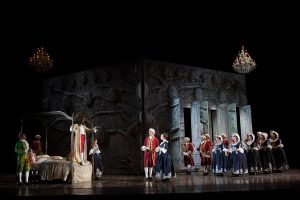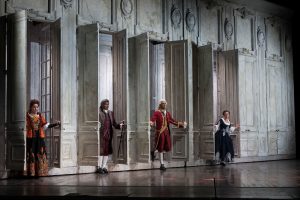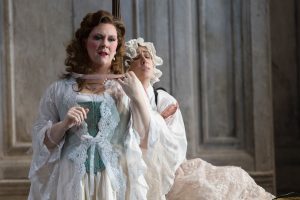SD Opera’s ‘Figaro’ Delights in 2018-19 Season Opener
Mozart’s The Marriage of Figaro, one of the most popular operas in the standard repertoire, seems like a natural to open San Diego Opera’s 2018-19 season. And, with a well-directed and sung production it proved to be an excellent start to what looks to be a strong season.
The second of French playwright Pierre de Beaumarchais’ trilogy of “Figaro” plays, The Marriage of Figaro follows the cast of The Barber of Seville as Count Almaviva (John Moore), having successfully wooed his love, the Countess (Caitlin Lynch), settles into married life. But the Count still has a wandering eye, and he plots to reinstitute a feudal rule that the lord may deflower any bride under his control before her husband can sleep with her for the upcoming marriage of Figaro (Evan Hughes), his manservant, and Susanna (Sarah Shafer), who serves the Countess.
Figaro has other problems with his marriage: Dr. Bartolo (Ashraf Sewailam), a lawyer who was one of the Countess’ suitors, searches for revenge against Figaro for aiding Almaviva’s successful efforts. Figaro borrowed money from Marcellina (Susanne Mentzer), Bartolo’s former housekeeper, promising to marry her if he didn’t replay the loan. The loan is due, and Bartolo plans to stand in the way of Figaro’s marriage to Susanna unless it is paid.
Comically getting in the way of the adult scheming, Cherubino (Emily Fons), a pubescent boy who has discovered a passion for women, becomes a key figure in plots between the Countess and Susanna to thwart both Almaviva and Bartolo so that Figaro and Susanna’s marriage can take place as scheduled.
Stage Director Stephen Lawless is a veteran of The Marriage of Figaro, and it shows. His staging is assured, and the singers interact with each other in both naturalistic and creative ways. He’s especially good at coaching the precise timing that makes the farcical scenes so funny. Leslie Travers’ scenic and costume designs contrast solid decorated walls containing lots of doors with costumes that vary from crimson red uniforms to white nightgowns. Thomas C. Hase’s lighting design emphasizes light against dark and features a number of scenes where stark lighting throws the performers’ shadows against the walls. Eric Sean Fogel provides choreography for dances that could fit nicely with the period.
Musically, the performance began with gusto, as Conductor John Nelson led members of the San Diego Symphony in the well-known overture, which is often played as a stand-alone piece on orchestral concerts. Mr. Nelson and the orchestra undergirded the singers particularly well, varying colors and volume to support different voice qualities. Chorus Master Bruce Stasyna shone in playing the continuo parts during the recitatives. His chorus appeared infrequently but had a surprise or two up its sleeve.
The singing exhibited reasonably consistent quality, along with some moments where the singers could shine. Particularly among those moments were Mr. Moore’s Act 3 aria, “Vedrò, mentr’io sospiro,” Ms. Lynch’s aria, “Dove sono i bei momenti,” in the same act, and Mr. Hughes’ lament about the fickleness of women, “Aprite un po’ quegli occh,” in Act 4. Ms. Fons didn’t have a single moment that stood out, but I was very impressed with both the mature tonal quality in her voice and her many small touches that made her Cherubino entirely believable.
Unfortunately, Ms. Mentzer was somewhat indisposed due to the dry Santa Ana winds, but she gamely acted her role and performed the recitatives while Los Angeles-based soprano Julia Metzler did a lovely job of singing the arias from one or the other sides of the stage. I feared that some indisposition may have affected Ms. Shafer as well. Her tone was inconsistent, and she had some trouble marshalling volume levels equal to her colleagues. The famous ensemble pieces were affected to some degree: the Act 2 closer found the performers blending reasonably well but not brilliantly with each other. On the other hand, the wonderful set piece that closes the production was a treat for both eye and ear.
At three hours and fifteen minutes, including one intermission, The Marriage of Figaro can be a long sit. San Diego Opera’s production was consistently engaging and made the sit an easy one. The season includes Rigoletto and Carmen, along with what should be fascinating productions of All is Calm: The Christmas Truce of 1914 and Jake Heggie’s “Three Decembers,” featuring Mr. Heggie’s muse, Frederica von Stade.
[box]Additional performances are scheduled for 7pm on October 23 and 26 and 2pm on October 28 at the Civic Theatre, downtown. Street and pay parking is available near the theatre. This review was based on the Saturday, October 20, performance. Tickets are available by calling 619-533-7000 or visiting https://www.sdopera.org.
DOWNLOAD CAST AND CREDITS [/box]





